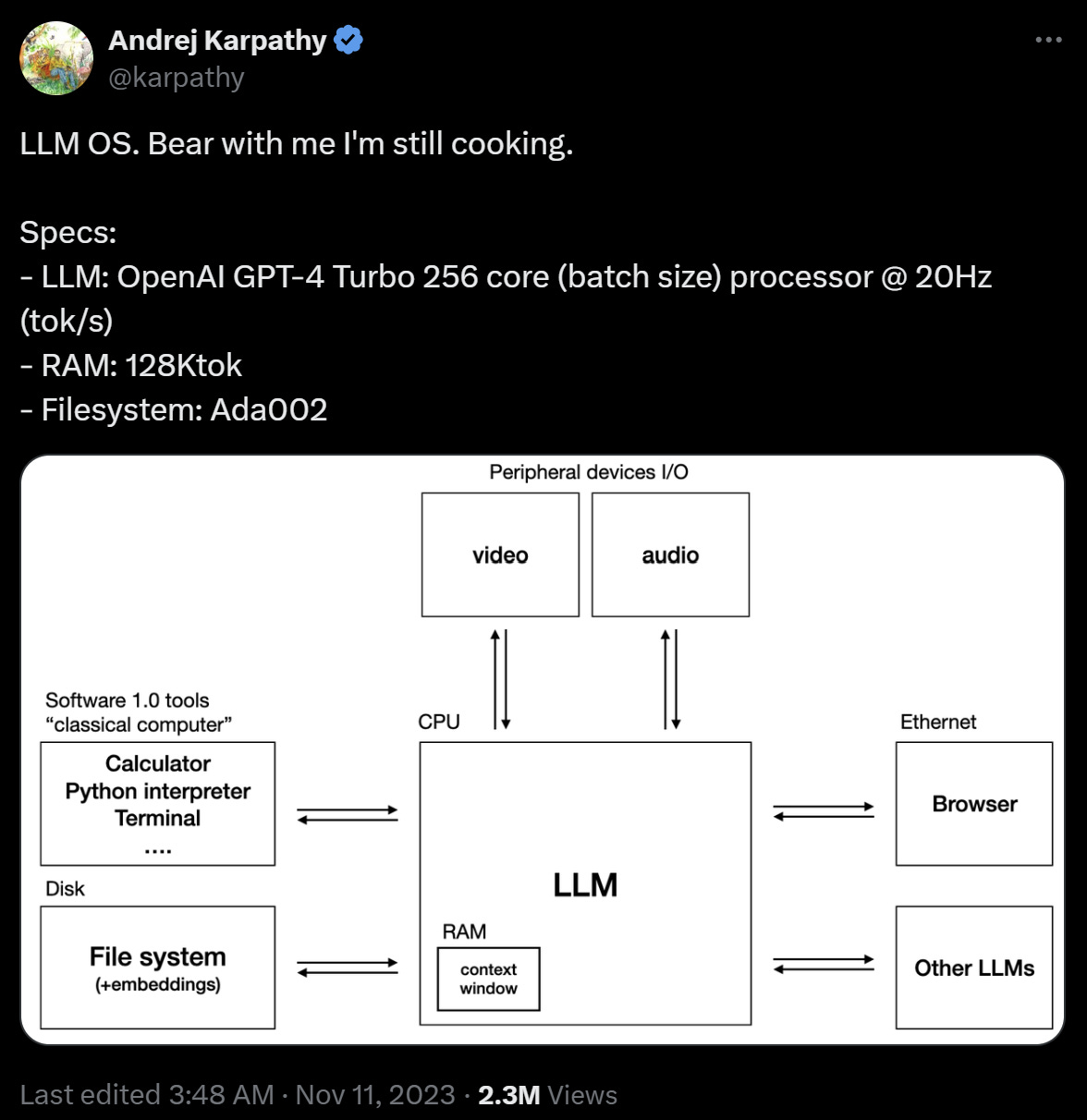Founder Spotlight: Ariel Harmoko @Artifact AI and agentic AI systems
Why agentic AI systems are the name of the game today and multi-agents that you can build yourself
Listen to a 9-minute pod on this article if you are on the go or just want a fun way to digest!
If 2022 was the year for the advent of the LLM (think ChatGPT), and 2023 was for compound AI systems (think enterprise AI), 2024 is the year when AI agents are the talk of the town. AI agents are basically ChatGPT with arms & legs. They have the ability to execute a multitude of tasks for you, based on your goals. This can be something as simple as sending an email to automatically respond to your clients’ requests. Or making restaurant bookings on your behalf synced to your travel itinerary or dietary requirements. Or, for our more product-oriented readers, make updates to your code based on customer calls so you can automatically iterate, test, and deploy new features. All of this is becoming possible with today’s emerging AI architectures based on agentic workflows.
The last couple of weeks were intense in this space as major tech companies have demoed their upcoming agentic products. Microsoft gave a demo on their Copilot Studio, Google showcased Jarvis, and Salesforce launched their own low-code agent building tool called Agentforce. What grabbed our attention the most was Anthropic’s beta release of Computer Use, which is an agent optimized to take actions on your local browser:
What many of us don’t realize is that with some technical intuition and hard work you can not only build an agent, but a multi-agent AI workflow highly specific to your use case today. OpenAI’s Swarm library is open source on GitHub for anyone to experiment with. Not to mention a plethora of instructional videos on how to implement this with OpenAI APIs and open source, locally run LLMs. If you are thinking of hiring an employee or a contractor to carry out a specific task, you may deploy an agentic framework instead.
Today, we dive deep into multi-agentic AI systems with one of our favorite startups, Artifact AI. Ariel Harmoko—Artifact’s Co-founder & CEO— is building an agentic platform for automating accounting for businesses. What intrigued us with Ariel and his co-founder Carter Springall’s approach is that they’re not only building an agentic product but also deploying multi-agentic AI systems to build their company in the backend. This allows them to find product-market fit and go-to-market fast with only a 2-person team, which is the real magic of being an AI-native founding team today.
Without further ado, let’s dive in:
Pamir: Tell us about how you became a founder and what your greatest passions are.
Ariel: I grew up in a competitive Indonesian household where hard work was non-negotiable. By the age of eight, I was go-karting competitively and went on to win three national championships. Balancing racing and academics taught me discipline early on.
Academically, my love for math and engineering led me to build computers from scratch and dive into coding. When I was 15, I started researching deep learning models at Cambridge, becoming the youngest ML researcher at the university. My focus was researching AI models to diagnose celiac disease early on, which showed me how tech can make a real impact—solidifying my belief in the power of innovation to change the world.

Pamir: What is the big problem you are going after as a founder?
Ariel: Accounting is essential for everyone and it's a massive, centuries-old industry with a $900B total addressable market. As we dug deeper into this space, we identified three major challenges: 1) the sector’s fragmentation, 2) outdated tech, and 3) loads of manual tasks, all adding up to tedious work and wasted time. Right now, the average accountant relies on 5-10 different tools, each with unique features, which not only stacks up costs but also results in hidden fees passed onto clients. As a business owner purchasing accounting services, you’re likely seeking peace of mind and willing to pay for whatever it costs—but it shouldn’t have to be that way. The ideal scenario? Businesses should receive top-notch service for the price they pay, every time. That's precisely what we aim to deliver. Today’s tech enables us to automate repetitive tasks like data entry, freeing accountants to offer strategic guidance and giving time back to them and the businesses they support.
Pamir: Why now? Why haven’t others gone after this problem before?
Ariel: We spoke to one of yesterday’s hot shots in this space called Zeitgold - an accounting automation company that was founded in 2015, raising around €50M which eventually got acquired by Deel. They struggled to scale, however, because they hard-coded every edge case directly into their backend. For instance, they collected receipts from restaurants using a physical receipt box that would be gathered daily and scanned. But now, with e-invoicing, everything is becoming more digital and real-time. With the advent of GenAI, many of these edge cases can be handled dynamically, without needing to hard-code solutions into the product.
Pamir: Tell us about Artifact AI and the big vision.
Ariel: Our vision is to become the global standard in accounting software, leading the way as the first to fully automate accounting from end to end. We’ve developed a customizable, agent-driven workflow that covers everything—from bookkeeping to tax filing and from data extraction to reconciliation. This boosts accountants' productivity by up to 90%. Our initial market focus is accounting firms, with plans to eventually reach businesses directly. We're starting with e-commerce and SaaS accounting, where digital integration is already strong. For example, if you’re a Shopify business owner, we integrate directly with Shopify and payment providers such as Stripe and Paypal to track your COGS, inventory, sales, and revenue, automating data collection along the way. One common pain point for accountants is chasing clients for invoices and receipts. Artifact tackles this by scanning documents directly from your email provider and cloud database, matching them with your transactions. With this data, the Artifact agent can even automate tax filing, creating a seamless end-to-end solution.
Pamir: What is a multi-agentic AI system? Why is it the hype these days?
Ariel: Think of ChatGPT as primarily text-to-text. Now, when we talk about agents—specifically LLM-based agents—it’s more like text-to-action. The distinction is that an LLM-based agent operates almost like an LLM in a loop, but with memory and states. Imagine the LLM as the CPU and its context space as the RAM. This is what makes this space so exciting; it is cutting-edge research that’s tough to crack. For example, say you prompt, “build me a competitor to Google.” With enough context, a master AI agent—essentially the orchestrator—can assign different tasks to sub-agents to get it done. To build a Google clone, this orchestrator could even manage and coordinate a virtual dev team. This “internal organization” of multiple agents working and communicating toward a common goal is what we call a multi-agent AI system.

Pamir: We’ve recently experimented with AI agents such as Anthropic’s Computer Use that are in beta right now. It's not perfect today as it sometimes churns out errors and gets in an infinite loop. Is this a theoretical problem or an engineering one to solve?
Ariel: It's still very much a research challenge, relying on frameworks like ReAct (Reason + Act) and AutoAct, where an LLM reasons, acts, and then reassesses if it hits a roadblock. What’s missing is genuine reasoning. With OpenAI's gpt-o1-preview model, you get a “chain-of-thought,” but it’s essentially text output used as reasoning. Unlike human reasoning, where we think internally before speaking, an LLM "speaks" first, then uses that to think, highlighting a gap in current model architectures. Plus, since these models are trained on platforms like Reddit and X—essentially data that is not smart—the data lacks the refined reasoning we’d get from top scientists and their thought processes as they generate complex ideas. For LLMs to improve reasoning, they need higher-quality data—only then can agentic frameworks truly advance.
Pamir: Your product is fueled by these multi-agentic systems and AI in general. How does this translate into building Artifact as a company in the backend?
Ariel: We’re an AI and agentic-first company through and through—from backend to go-to-market and sales. With our agents, given the right rules and prompts, we’re solving tough challenges and producing high-quality code that goes straight into production, giving us a strong competitive edge with Artifact. It’s what has enabled us, as a two-person team, to move fast and efficiently.
Interestingly, we haven't come across many investors and founders who truly understood this angle. And when I started speaking with you and Maxim Matias, it felt like, finally, someone gets us! We want to validate this unique, AI-native approach, which has already shown real business value. Our system even identifies market shifts and finds the right leads through in-house agents, like our multi-agent conversational tool for accountants managing taxes and filings, tapping into valuable data across integrations.
Seeing real business value already come from this approach gives us the conviction to stick with our AI-native philosophy and aim to be not just 10x but 100x founders.
Pamir: You mentioned that a lot of founders have not internalized such an approach to build their startups. Why do you think this is the case?
Ariel: Over the past three months, I’ve spoken with 300-400 founders, and only about 10 are truly committed to building in the agentic space. These companies are already thriving and generating significant revenue. For instance, one of our U.S. competitors hit $1M ARR in their first year. I believe most founders aren’t building their companies bottom-up with AI agents because this space is still new and requires deep technical knowledge of LLMs to stay current with the latest advancements. It’s also challenging to convince non-technical founders that this unconventional approach is the future of company building.
Pamir: How can founders begin to build their companies in an AI-native way? How can they build their internal tech stack from the ground up?
Ariel: First, I recommend anyone starting in this space to build a tailored evaluation framework for different LLMs based on your use case. LLMs are improving daily, closed models are affordable, and open-source options are abound—though hosting costs can add up for the latter. The key is identifying which LLM works best for tasks like code generation, summarizing, or rewriting within agentic workflows.
Next, integrate frameworks like LangChain and LlamaIndex. I’m a fan of LlamaIndex—it lets you easily connect and configure LLMs for specific systems. For those ready to go beyond, creating proprietary frameworks can be a game-changer.
The beauty of this approach? You don’t need to be a technical founder. Even starting with ChatGPT, you can guide yourself to build such workflows that not only boost your efficiency but also drive growth, making you more competitive in the market.
Pamir: What comes after multi-agentic systems?
Ariel: Full autonomy. I’m drawn to the 5-level autonomy model for self-driving cars and believe GenAI will follow a similar path. Agents are the future, and the next big leap may be on the hardware front, which is incredibly exciting. We’re already seeing a push in AR/VR—Meta’s leading there—and the Tesla Bot is gaining traction. The fusion of multimodal AI with hardware, enabling interaction beyond chat to include vision and more, is going to be thrilling to watch.

If you are building the next one-person unicorn, we want to talk to you.
Get in touch here: hello@blackbird.associates




